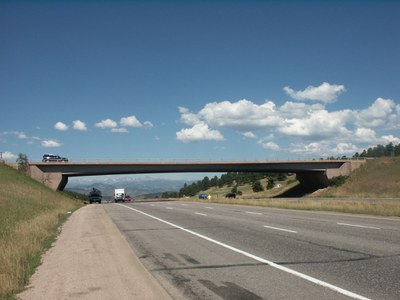Research Projects
Overview
CDOT has spearheaded a variety of research projects that serve to both streamline the Section 106 process and give us a better understanding of historic resources in Colorado. Some research projects focus on CDOT-owned assets such as bridges and highways, while others focus on historic resources that are often encountered on CDOT projects, such as irrigation ditches and buried trolley lines.

Bridge Inventories
Since 1983, CDOT has conducted several historic bridge inventories that have resulted in the evaluation of thousands of the state's historic bridges to determine their eligibility for listing in the National Register of Historic Places (NRHP). These inventories have been used to streamline the Section 106 process associated with bridge repair, rehabilitation, and replacement projects but have also provided valuable information about the historic significance of the state's many bridges. The most recent statewide historic bridge inventory was completed in 2014.
1983 Historic Bridge Survey
- Total of 544 bridges surveyed, including 139 on the Federal Aid Highway
System ("on-system"), 337 off the Federal Aid System ("off-system"), and 51 Federal Aid Urban (FAU) - Pre-1945 bridge types surveyed: timber, iron, and steel trusses; iron, steel and concrete girders; steel, concrete and stone arches; concrete rigid frames
- Resulted in 64 NRHP-eligible bridges based on point rating system
1987 Historic Bridge Survey
- Total of 7,000 bridges evaluated (on- and off- system), primarily from post-1945 period.
- Evaluated bridges less than 40 years old, of common structural types, or missing from off-system inventory
- Resulted in 2 NRHP-eligible bridges and 16 potentially eligible bridges
2000 Historic Bridge Inventory
- Evaluated 2,158 bridges (on- and off-system)
- Resulted in 208 NRHP-eligible bridges, 1,453 not eligible, and 497 potentially eligible bridges
2014 Historic Bridge Survey
- Evaluated 749 bridges constructed between 1959 and 1968 (on-system only)
- Resulted in 6 NRHP-eligible bridges and updated eligibility determinations for the roughly 400 bridges determined “potentially eligible” in the 2000 survey
Highway Bridge Multiple Property Documentation Form
As part of the 2000 Survey, CDOT completed a Highway Bridges of Colorado Multiple Property Documentation Form. This document facilitates the listing of Colorado’s bridges in the National Register of Historic Places (NRHP). It provides a historic context of bridge development in the state, details criteria and areas of significance based on NRHP specifications, and lists registration requirements for listing bridges under this MPDF.
As a result of the MPDF and the 2000 Bridge Inventory, CDOT partnered with the Colorado Historical Society (now History Colorado) to nominate 29 of Colorado’s highway bridges for listing in the NRHP.
Highway Studies
CDOT Historic Highway Inventory
Roads and highways can be historically significant resources, and since almost every CDOT project involves a road or highway, these resources are often evaluated to determine project effects. Completed in 2016, CDOT’s Historic Highway Inventory evaluated the significance of Colorado’s 151 US and state highways based on the National Register of Historic Places (NRHP) criteria. The study found that 77 highways are historically significant, and 74 are not historically significant. This is an important streamlining measure for CDOT cultural resources staff because CDOT now has information on the significance of all highways and is not required to conduct a Section 106 review of the non-significant highways.
Highways to the Sky: A Context and History of Colorado's Highway System
Completed in 2002, Highways to the Sky includes an historic overview of highway development in Colorado and guidelines for determining NRHP eligibility of roads and other road and highway-related resources.
Colorado State Roads and Highways Multiple Property Submission
Based on the content in Highways to the Sky: A Context and History of Colorado’s Highway System, the Colorado State Roads and Highways Multiple Property Submission was developed in coordination with the Office of Archaeology and Historic Preservation as a means for understanding and evaluating the historic significance of Colorado’s state highways. It provides a historic context of highway development in the state, details criteria and areas of significance based on NRHP specifications, and lists registration
requirements for listing roads and highways under in the NRHP. Overall, it aids CDOT Cultural Resource staff in the evaluation of road and highway segments for NRHP eligibility.
Historic Bridge Management
Completed in 2019, Phase 1 of CDOT’s Bridge Management Plan focused on 132 on-system and off-system bridges that are NRHP-eligible or NRHP-listed. A multi-disciplinary panel of engineers and historians examined each bridge to determine its suitability for preservation in place.
A methodology was established to characterize each bridge as High Priority, Medium Priority, or Low Priority for preservation in place, with High Priority bridges exhibiting the best conditions for potential rehabilitation in place. The methodology involved two screening mechanisms. The initial screening reviewed the condition of the bridge in the context of National Bridge Index data, such as geometry and structural capacity, and assigned a “condition score” to the bridge. A second step of analysis included a review of other criteria such as deficiencies in the bridge and how/ if these can be addressed through rehabilitation, along with considerations such as detour length, load capacity, and ability for rehabilitation based on the Secretary of the Interior Standards. These two screening processes were then used to prioritize the bridges. The study resulted in 91 High Priority bridges, of which nearly half are on-system, or CDOT owned.
This study will be used by internal CDOT staff to inform and improve project delivery, as related to Section 106 and Section 4(f). It will also aid in the evaluation of rehabilitation options and maintenance and management of the state’s bridges and culverts. A broader goal is to use the study to assist the agency in preserving on system high priority bridges. CDOT is currently developing a Phase 2 of the project to identify a subset of bridges that the agency will commit to preserving in place.
